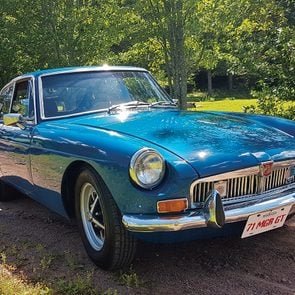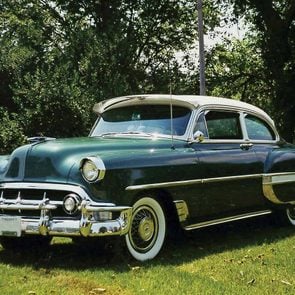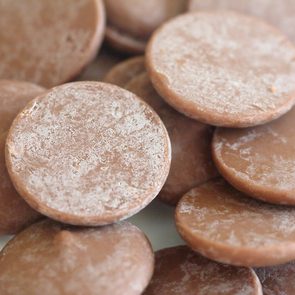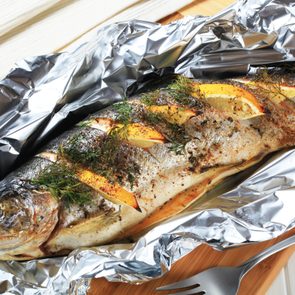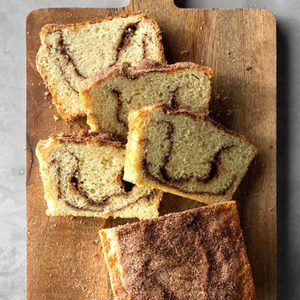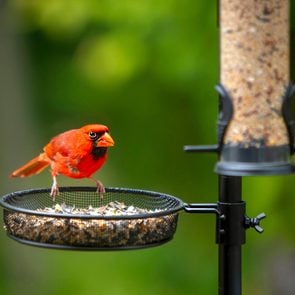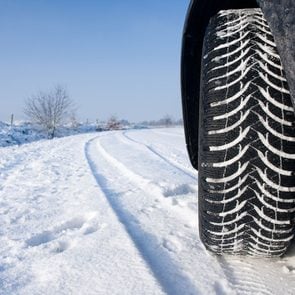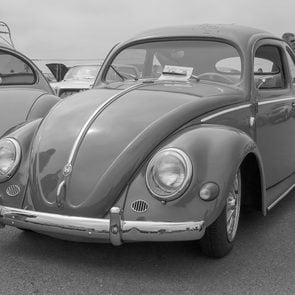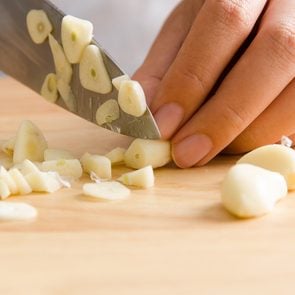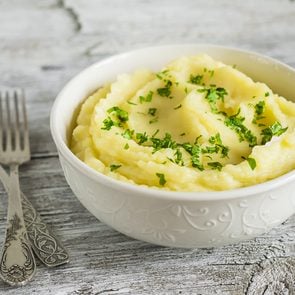Reader’s Digest Canada: January always inspires talk about seasonal affective disorder. But what exactly is SAD?
Deanne Simms: It’s a kind of depression that is brought about by the changing of the seasons, most commonly the switch from long summer days to shorter, darker ones. About 15 per cent of Canadians will experience mild SAD in their lifetime, while two to three per cent will deal with more serious cases. Symptoms include feeling sluggish or low most of the day, and a reduced interest in activities they once enjoyed. Other signs of seasonal affective disorder are changes to appetite—often eating more and craving carbohydrates—and oversleeping.
Sluggishness and sleeping a lot probably describes many Canadians at this time of year.
That’s true, but there are differences between the more typical “winter blues” and SAD. When the symptoms I described start to interfere with a person’s daily life, that’s when I view it as a clinical diagnosis. For instance, a person experiencing SAD might tell me they feel irritable and more sensitive in their relationships with others, causing them to withdraw socially. Severity is another marker. SAD is a type of depression and can become very serious up to and including suicidal thoughts—and sufferers are usually distressed that they can’t get rid of the symptoms. For many of us experiencing a lower mood, we might reach out to friends or do something that brings us joy—but a person who’s depressed often lacks the ability to do that.
What’s happening in the brain when someone experiences SAD?
We still have a lot of questions, but what we know is that people with the condition have a disrupted circadian rhythm—your body’s mechanism for regulating your sleep/wake cycle—and that may be partly related to less sunlight. Sometimes SAD also comes with abnormalities in the way our brains produce or transmit chemicals like dopamine (which is associated with happiness) and serotonin (which regulates mood)—which may also relate to a lack of sunlight.
Canada has dark winters. Do we also have more cases of SAD?
Yes, and rates do vary according to latitude, so places that are further from the equator tend to have more occurrences of the condition.
So could you treat SAD by booking a trip to a sunny locale in the winter?
I like where you’re going with that—and if I could prescribe a trip down south, I would love to. Theoretically, going to a place where you’re exposed to more sunlight and a change in scenery could be effective, at least in the short term—but again, it’s important to remember that depression can take the enjoyment out of things a person would normally find fun.
What kinds of treatments have you found to be effective?
Light therapy, where you sit in front of a special lamp for 30 minutes a day every morning, can positively impact brain chemicals tied to mood and sleep—and so ease symptoms. In my practice, I’ve also found success with cognitive behavioural therapy, where I help clients create a better sleep schedule and to notice and shift unhelpful thoughts tied to SAD. The goal is to fight back against the urge to “hibernate” in the winter and to instead structure their lives and activities to increase their physical activity and social connection.
Now that you know the signs of seasonal affective disorder, check out the health benefits of light therapy (beyond treating SAD).
Like most teenagers, I could not wait to get my driver’s licence. So strong was my desire that I overcame the dread of learning how to drive from both my father and the slightly unsettling driver’s ed teacher at the local high school. The promise of independence trumped all fear.
Not long after obtaining my licence, I began longing for my own car. Sure, I had ready access to my parents’ vehicle, but it was a maroon 1984 Mercury Lynx station wagon that was only slightly less embarrassing to drive than being “pantsed” in a school hallway. In retrospect, I’m convinced this wasn’t a coincidence.
There was also a catch. My father is a meticulously practical man, and though he freely offered up the keys to the family car, this privilege came with the clear caveat that not only would I pay for my own fuel, I would also pay him mileage to account for the wear and tear I was exerting on this nadir of North American automotive design. I was essentially renting the family car from my dad.
After a full year of this perceived injustice, I was so desperate for my own wheels that I set about persuading my dad, using his own rigid rationalism as my secret weapon. Armed with a calculator, an assortment of data derived from insurance company brochures and gas-consumption statistics my father kept on all his vehicles, I produced a conclusive four-page document justifying how I could afford to purchase and care for my own vehicle, using my accumulated savings and part-time summer wages from my job at the local hardware store.
My efforts may have impressed him, but he remained unmoved. It wasn’t until the fall of my final year of high school, nearly three years into my driving career, and facing a daily commute to university on the horizon, that he finally relented and helped me purchase my very first car—a 1985 Honda Prelude.
I really wanted the bright red Pontiac Sunbird GT I first test drove. But it was classified as a sports car, which meant a $3,000 annual insurance bill for a teenage male driver like myself, well over my budget.
Actually, I didn’t even like my first car—at the beginning anyway—mainly because it was grey and there’s nothing more bland than a grey car, no matter how sporty the model. In hindsight, this likely explains why I can’t find a single photo of my first car as it looked when I bought it. You’d think that would be the first thing any proud teenager would do, no matter how laborious photography was in the pre-digital era.
I do have many memories associated with that car, like the first time I took my friends out for a drive. It had a manual transmission, which made the car feel more like a race car in my mind—but also made it exponentially more difficult to drive for someone who’d never set foot on a clutch before. There were five of us crammed in there and at one stop sign, I repeatedly stalled the car. It took nearly a dozen increasingly humiliating attempts to proceed before I realized I was in third gear, not first.
I would eventually come to love that car, as one loves a first car, even a grey one. That’s why I do have a picture from the last time I ever saw it. The photo was taken 30 years ago at a wrecker’s yard, in a town where I had been working as a summer co-op student during my first year of university. It was the final day of my work term and I had scooted into the city for a few necessities when another driver, blinded by the sun, pulled out right in front of me. My 1985 Honda Prelude was a write-off. The next day, I returned to gather some belongings I’d left in the car… And to say goodbye.
Next, read the incredible story of how one man missed out on his dream car—then found it parked in his driveway 25 years later.

Sometimes one plus one does equal three, as was the case when Dave McNee met Claudia Mandekic 14 years ago. McNee, then 27, was at a dentist appointment in Toronto when he started chatting with Mandekic, 30, who was working the front desk there while studying to be a teacher. When she told McNee how hard it could be to get students excited about math, her favourite discipline, he made a surprising suggestion: “Why not throw in something they enjoy, like sports?”
The idea of mixing basketball and mathematics got its first shot a couple years later, in 2011, when the now-colleagues—who had launched a tutoring non-profit—were invited to run a summer-school program for kids who’d failed Grade 9 math at Georges Vanier Secondary School.
When the students showed up for their first day, they weren’t exactly thrilled, says Mandekic. Over the next few hours, she and McNee gave the kids techniques to improve their shooting while also helping them calculate their field-goal percentage—which, in turn, taught them about fractions and decimal points.
At the end of the game, the winning team was determined based on which group had the highest total percentage and had done the most efficient math. “When the bell rang, they were so fixated on collecting their data and figuring out which team won that they didn’t leave,” says Mandekic. “I realized we might be onto something.”
The classes, later named BallMatics, soon spread to other Toronto schools. “I was terrible at math,” says Duane Douglas, who was a Grade 8 student enrolled in a fast-track summer program in 2014 when the founders came to Oakwood Collegiate Institute.
“But once I started BallMatics and realized the sport I loved was directly tied to math, it made me a lot better at it,” says Douglas. “Every time I played basketball, I was thinking about math.”
Almost any math problem, McNee and Mandekic realized, can be taught on the court. Kids can learn how to navigate an X-Y grid to find their next shooting spot or absorb the basic principles of trigonometry based on the angle at which they release the ball.
Since its founding, BallMatics has been hitting only net. After-school programs were added, as well as a dozen teachers, coaches and volunteers. And in 2019, the organization landed a lease for a 10,000-square-foot space in Toronto’s west end.
McNee and Mandekic have since established a private high school there called Uchenna Academy. At the school, which has 26 full-time students and provides subsidies for those who need financial assistance, kids with elite basketball skills can study all subjects, train at their sport and work part-time helping out with the BallMatics after-school programs.
Currently, Uchenna serves only boys, but as more girls join BallMatics, McNee hopes to change that. And for anyone who can’t make it to the courts, the organization recently rolled out an app that can teach math through basketball off campus.
For three of the school’s first graduates, the value of BallMatics is clear: last year, the boys landed university scholarships for their performance in the classroom, not on the court. (Though they also made the basketball teams.)
While he was in high school, Douglas—now 20 and earning a degree in education—split his time between Oakwood and Uchenna. He believes the school’s commitment to academics is the key reason it’s been a winner.
“If we didn’t do our work, we weren’t playing at the game,” he says, explaining that coaches would bench kids who didn’t keep up in class. “At Uchenna, we were student athletes, after all, not athlete students.”
Next, read up on the volunteers who are helping Canadian seniors become computer-savvy.
The most common reason for that rapid clicking noise when your car fails to start is a dead battery. However, a single click could mean a malfunctioning starter motor, or something even more ominous. Here are the most frequent reasons why a starter clicks when you’re trying to start your car.
Car Starting Basics
Turning the ignition key or pushing the “Start” button sends battery power flowing through the ignition switch to the starter relay or starter solenoid and computer (ECM). The relay/solenoid is the switch that engages the starter motor. That sends full battery power to the starter motor, engaging a pinion gear (also referred to as a Bendix Drive) that meshes with and spins the flywheel ring gear. The flywheel turns the crankshaft which gets the pistons moving up and down in the cylinders.
The ECM meters air and fuel into the cylinders and signals the ignition system when to fire the spark plugs, igniting the air/fuel mixture compressed by the pistons. And then your engine starts!
So What’s That Clicking Noise?
Clicking when starting usually means the starter motor pinion gear is crashing into the flywheel due to a depleted battery that doesn’t have enough “juice” to spin the engine. (Learn how to test a car battery.)
Multiple clicks (rapid clicking)
Rapid clicking usually indicates there is enough power in the battery to bring the starter motor to life but not enough to crank the engine. When it can’t get your engine spinning, the starter motor turns off and on. Each time it turns on, the teeth of the pinion gear clatter against the teeth of the flywheel. That’s the clicking that you hear.
Single click
A single loud click when starting (even after trying to jump-start your battery) is usually caused by a faulty starter motor, starter relay/solenoid or other electrical problem. However, if your engine has locked up (seized) the starter pinion will smash into the flywheel, making a loud clunking noise as it tries to crank the engine.
What To Do When Your Car Won’t Start (Multiple Clicks)
Jump-start the battery
Safety warning: A car battery contains sulfuric acid that can cause serious burns. Always wear gloves and eye protection when working around a battery or jump-starting a car. If you come into direct contact with battery acid, flush with plenty of water and get medical attention immediately.
Jump-starting your car while following all safety precautions is typically the quickest way to start your car when you hear clicking. (Here’s how to jump start a car safely.)
Battery Terminals
Battery cables are attached to your battery at battery terminals. If the terminal connections are corroded or loose, electrical power flow from the battery to the starter is reduced, keeping your car from starting even with a jump.
Removing the cable ends, cleaning off the corrosion with a wire brush and retightening the bolts should restore full electrical power to your car. Also, check that the negative battery cable connection at the engine block is clean and tight.
Starter Motor
Clicking or grinding sounds when trying to start your car can be a sign the starter motor has failed and may also be the reason a jump was unsuccessful.
Excessive cranking due to a hard-start condition can overheat a starter motor, damaging internal mechanical or electrical components leaving the starter unable to “crank” the engine. Also, a loose or corroded starter relay wire or connection will cause battery voltage to drop before reaching the starter.
Let your mechanic diagnose starter motor problems.
Charging System Problems
A defective alternator can keep a battery from fully charging. A worn or loose drive belt or a weak belt tensioner will also keep a battery from fully charging. Replacing a drive belt is a DIY task but leave alternator/charging problems to the experts.
What To Do When My Car Won’t Start (Single Click)
Jump-start the battery
Jump-starting is still the simplest DIY task if your car doesn’t crank. Sometimes the power of two batteries (your car’s and a helper battery) can free up a stuck starter motor.
Whack the starter
If you can safely reach the starter motor, try banging it with a hammer, your shoe or the tire iron from your trunk. Sometimes the electrical contacts get stuck and can be freed by tapping on the starter.
Recycle the key
Turn the key to the “Start” position (or push the “Start” button) 10 times in a row. Wait five minutes, and then try to start your engine. Call for a tow if these fixes don’t work. (Here’s more advice on what to do when your car won’t start.)
The Last Word
Although there is no basic starter motor maintenance, weak batteries and starting and electrical system problems shorten starter motor life. Problems causing extended cranking should be promptly diagnosed and repaired.
Once a month, check that your battery terminals are clean and tight, battery fluid levels (in batteries with removable caps) are correct and the battery is secured. That can prevent damage while prolonging battery and starter motor life.
Next, find out what nine other strange car noises could mean.
Have you ever wondered why aluminum foil has two sides?
It’s a common question and one that we’ve been too afraid to ask our mothers: Should we use the shiny or the dull side of aluminum foil when we cook? And have we been doing it wrong this entire time?!
Concerned cooks can breathe a sigh of relief: As it turns out, there’s no “correct” side of aluminum foil to use when cooking. According to the Huffington Post, they’re both equally effective at heating your food—so just choose whatever side you prefer.
If there’s no trick to it, then why, exactly, does aluminum foil have a shiny and a dull side in the first place? Experts at Reynold’s Kitchen say that the difference between the two sides is due to a manufacturing process called milling, during which heat and tension is applied to stretch and shape the foil. Two layers of foil are pressed together and milled at the same time, because otherwise, it would break.
“Where the foil is in contact with another layer, that’s the ‘dull’ side,” Reynold’s explains. “The ‘shiny’ side is the side milled without being in contact with another sheet of metal. The performance of the foil is the same, whichever side you use.”
But pay attention if you are using non-stick foil; in that case, there is a difference between the two sides. Since the non-stick coating is only applied to one side, you’ll want to use the dull side. Side note: There will be a label that designates the “non-stick side” in case you forget.
Next, check out 40 clever aluminum foil hacks you’ll wish you knew sooner.
Bread is considered the enemy in certain low-carb quarters. Its “unhealthy” reputation stems from the low-carb diet myth that all carbohydrates are inherently bad. Although it’s true that heavily processed, refined carbohydrates and sugary foods lack nutrients, not all types of carbs or bread fall into this category, says Malina Malkani, RDN, a registered dietitian nutritionist in Westchester, New York. It’s possible for bread to be part of a healthy diet.
In fact, depending on the loaf, bread can be packed with nutrients. Whole grain bread, for instance, is a good source of B vitamins, including folic acid, iron, magnesium, selenium, and dietary fibre, according to the American Heart Association.
Another common belief about bread is that it causes weight gain. Research in the Journal of Nutrition, however, found that weight gain—and increases in abdominal fat over time—is lower in people who consume more whole grain foods such as whole grain bread.
Although there are many different types of bread, we looked at seven categories of bread commonly found in supermarkets: whole wheat, whole grain, sourdough, flax, rye, oat, and gluten-free bread. We researched the real difference between these loaves—and which one is the healthiest.
Trust only the ingredient and nutrition labels
One thing that Lisa DeFazio, RDN, a registered dietitian nutritionist in Los Angeles, looks for is whole wheat or whole oats as the first ingredient on the list. “Be careful,” she says. “Wheat bread or multi-grain is not always a whole grain product.” That’s why it’s important to look at the ingredients list instead of whatever the brand packaging says.
Look for a short list of recognizable or pronounceable ingredients, Malkani recommends. Again, check that whole grains or sprouted flours are the first ingredients because the list is in descending order of predominance by weight.
Next, check out the nutrition label. The healthiest breads are higher in protein (about 3 to 6 grams per slice) and fibre (roughly 3 to 5 grams per slice) and lower in added sugar (less than 4 grams per slice), Malkani says.
Here’s how to read nutrition labels like a pro.
Don’t buy bread based on its colour
When buying healthy bread, keep in mind: The colour of the bread is almost meaningless. Sure, whole grain bread is darker than white bread. But manufacturers may add food colouring to give their processed bread a darker appearance and trick nutrition-savvy shoppers who want healthy wheat bread, according to DeFazio. Again, make sure to check the ingredients label.

Healthier types of bread
100 per cent whole wheat
Whole wheat is the first type of healthy bread that typically comes to mind. The flour used to make 100 per cent whole wheat bread is less processed and retains both the bran and germ of the wheat grain, according to Malkani. Whole grains, including whole wheat, have been linked to a range of health benefits, including decreased risk for type 2 diabetes, heart disease, and weight gain, according to the review of studies in the Journal of Nutrition.
Sprouted whole grain
Sprouted bread is made from whole grains that have sprouted from exposure to heat and moisture, says DeFazio. This process increases the grains’ antioxidants. Malkani adds that the sprouted grains in sprouted grain bread have a higher enzyme content, too. (Find out more foods that are high in antioxidants.)
According to Critical Reviews in Food Science and Nutrition, these grains contain more protein and more bioavailable, high-quality nutrients than other grains, and may be easier to digest. Most sprouted breads are high in fibre and protein, per research in the journal Nutrients. So swapping out your white bread for sprouted whole grain is a simple way to get more fibre in your diet.
The benefits of sprouted whole grain bread may also extend to weight loss due to its lower carb count. According to a study in the Journal of Nutrition and Metabolism, sprouted grain bread has fewer carbs, with 34 grams in a four-ounce serving, compared to 44 grams in 12-grain bread.
The sprouting process allows the grains to absorb more water, lowering the carb content. “Sprouting breaks down the starch in grains and reduces the carb content,” DeFazio says. As a result, “sprouted grains do not spike blood sugar like white bread.”
Whole wheat sourdough
This bread is easier to digest than others, thanks to the prebiotics and probiotics created during the fermentation process, according to DeFazio. The fermentation process that’s used to make whole wheat sourdough bread helps reduce the number of phytates that bind to certain minerals and impair their absorption in the body, according to a study in the Journal of Agricultural and Food Chemistry. As a result, Malkani says that whole wheat sourdough bread is digested more slowly in the body,helping stabilize post-meal blood sugar levels.
Flax bread
Flax bread uses whole grain flours and flaxseeds, according to DeFazio. “Flax bread contains omega-3 fatty acids that are good for heart health,” she says. Bread made with flaxseeds is an especially great bread option for vegans who need more healthy fatty acids in their diet.
These superseeds are also a good source of fibre, protein, and antioxidants. One study in the Journal of Food Science and Technology found that eating flaxseed bread and other flax foods may benefit digestion-related health issues.
Sprouted rye bread
Rye looks like wheat bread, but is darker and denser. Research in Nutrition Journal found that rye may be healthier in terms of making you feel fuller while not affecting blood sugar. Much like sprouted whole grain bread, sprouted rye is a good source of fibre, especially in comparison to regular rye bread. “Sprouted rye bread is high in soluble fibre, which slows your digestion of carbs and decreases the insulin response,” DeFazio says.
Oat bread
One of the newest types of healthy bread on the grocery store scene is oat bread, which includes both oats and whole wheat flour as the primary ingredients. If cauliflower can turn into a pizza, then your favourite breakfast food can absolutely turn into bread.
The best part is that there are already plenty of benefits of eating oatmeal. Oats are high in nutrients like magnesium, zinc, and iron. Plus, the high fibre content may help lower cholesterol levels and decrease high blood pressure, according to research in the American Journal of Clinical Nutrition and Vascular Health and Risk Management.
Find out more natural remedies for high blood pressure.
Gluten-free bread
Gluten-free bread doesn’t have grains like wheat, rye, or barley, according to DeFazio. Instead, gluten-free bread is a mix of gluten-free flours such as brown rice, almond, coconut, tapioca, potato, or corn flours. Gluten-free bread is good for people who need to avoid gluten, like those with signs of celiac disease or gluten sensitivity.
When manufacturers remove gluten, they add other ingredients to compensate because they need the bread to be chewy and have texture, DeFazio explains. So gluten-free bread often has refined flours, added sugars, gums, and tapioca starch that can cause gas, bloating, diarrhea, and gastrointestinal issues. (Here are more sneaky reasons you’re feeling bloated.)
DeFazio urges those without celiac and or gluten allergies to opt for regular bread. Some people without these health issues mistakenly think if they avoid gluten, they will lose weight, she says. Keep in mind that avoiding gluten will not automatically result in weight loss, nor is it necessarily healthier than other types of bread.
Bottom line: What’s the healthiest type of bread?
Bread is not the enemy. “Find a bread you enjoy that is also healthy,” suggests DeFazio. If you hate the taste and texture of one type of bread, move on and find another.
The healthiest bread option for you really depends on a few factors. Bread made with 100 per cent whole grains is less processed and offers more health-promoting nutrients per calorie than bread made with refined flours. That alone makes it the best healthy bread option for most people, according to Malkani. Sprouted grain bread and whole grain sourdough are good choices for those with digestive concerns, she adds.
Look for bread that features whole grains and is high in fibre, but low in sugar. If you use the tips from Malkani and Defazio and choose a loaf from one of the healthiest bread brands, you’ll make a foolproof, tasty choice every time.
Next, find out the bread buying mistakes everyone makes.

A Bird-Watcher’s Guide to Grey-Bruce
Grey and Bruce counties are a well-kept secret—and not only for their sunsets, hiking escarpments, beautiful beaches and waterfalls. The area is also an incredible place for birding. Over the years, I have been surprised to see how many species of bird make their way home along the coastline of Lake Huron in the Grey-Bruce region.
As a photographer, these creatures draw me outside to explore all of the scenery that makes being outdoors so great.

Eagle Scout
One of our feathered friends is the eagle. These beautiful birds of prey with feathered heads are extremely distinguished. Eagles are the nomads of the skies, habitually related to the sky gods. They characterize honesty, truth, leadership, courage and freedom, and many Indigenous cultures hold them as sacred.
Eagles can be seen here in Bruce and Grey counties year-round. They have become accustomed to our climate and society. The presence of this magnificent bird can be seen over larger lakes where food is in abundance.
The eagle can live more than 20 years. Its wingspan can extend to nearly three metres, its body length to a metre. Picture a bald or golden eagle soaring above your head; it’s an amazing view.
The bald eagle looks majestic as it hovers over the water looking for its prey, plunging in to grab a fish near the surface with its strong talons. Eagle eyesight is about five times better than a human’s. They can even spot a fish from a kilometre and a half away. They usually love to nest in large pine or poplar trees to have their dinner.
Eagles also feed on aquatic birds, amphibians and reptiles. This is most likely why they love the Grey-Bruce; there are beautiful lakes all around. Eagles love the rocky shores of the Niagara Escarpment and Georgian Bay coastline, which is ideal year-round for this bird of prey. You can see eagles close to the nuclear power plant because of the open water and abundance and variety of fish that surround the plant.
Check out the best bird-watching spots in every province.

Be Wise With Owls
Contrary to eagles, which hunt during the day, owls are nocturnal or crepuscular birds that prefer to hunt for food in the dark. They have immobile, tubular eyes that provide binocular vision and enable them to fully focus on their prey.

Some owls are comfortable with humans, so photographers can often get good pictures without troubling them too much, but over the years as a photographer I have learned that if an owl is ignoring you, it’s a compliment. When photographing owls, respect their environment by maintaining distance; stay in your car or far away from their territory. If the owl is looking around and away from you, you are stressing this picturesque bird. It might be telling you it’s preparing to fly away, so if you spot an owl always respect its space.

Lately there have been more owls in the Grey-Bruce due to a shortage of prey further up north, where they usually hunt for food. To scout out owls, look for open fields, fences, utility poles or tall trees where they can observe possible prey. Also, the presence of whitewash—splatters of chalky paste on the ground and tree branches, are found around owl roosting spots.

Ready, Set, Egret!
These gracious wading birds have tall legs and long, curved necks. Great egrets have been a proliferating sight in Bruce and Grey counties these past few years. I’ve noticed large numbers of great egrets settling on the beaches in Oliphant, Ontario. The long shoreline and shallow waters are a haven for these beautiful birds.
Great egrets are resourceful scavengers. They walk in shallow water to search for fish, frogs and other small aquatic animals. I have observed these birds standing still for hours, watching and waiting for their unsuspecting prey to pass by. With amazing speed, the egret strikes, poking its long bill into the prey’s neck. Dinner at last!
The rare reddish egret is a medium-sized heron that breeds in Central America, the Bahamas, the Caribbean, the Gulf of the United States and Mexico.
The reddish egret must have taken a wrong turn a couple of years ago when it showed up in Oliphant, encouraging bird lovers to flock to the area. Onlookers from Toronto, Ottawa and even Vancouver stopped by to appreciate the rare sight.
The reddish egret is considered one of the most active herons and is often seen on the move. It will even run around as it hunts for fish in shallow water. This clever bird even casts shadows with its wings to reduce glare on the water, helping it to see better as it prepares to spear its prey. The result is a fascinating dance.
Don’t miss this gorgeous gallery of Canadian birds.

Blue Note
The great blue heron has a blue-grey plumage, and it can be seen standing quietly or taking long, purposeful strides as it hunts. You must be very patient to catch them in action. They move slowly, but they can attack in a blink of an eye to grab a fish or snap up a gopher.
In flight, they are graceful and elegant, the most beautiful bird to look at. The heron flies with a tucked-in neck, long legs trailing out behind.
Great blue herons aren’t likely to stop over in a typical backyard. However, the bird might sometimes play the role of an unwanted visitor if your backyard includes a fish pond.

Crane Domain
Another bird that resides in Bruce and Grey counties is the sandhill crane.
The voice of the sandhill crane is sure to be heard from far away. Its loud, rolling trumpet call can be heard up to four kilometres away. This bird is also known for its spirited ballerina-like dance. Tall and red-capped, it is an especially attractive and refined bird.
I’ll never forget one snowy late-autumn day when I was on my way to do a photo shoot. There were several sandhill cranes close to the highway, flying, just singing to one another. It was incredible. I was mesmerized by them still being in the area in that cold weather.

The Endless Appeal of Bird-Watching
In this time of uncertainty—or anytime—bird photography is for everyone. Being outside in the fresh air and enjoying your surroundings with Mother Nature is a healthy choice all around. It’s always on my to-do list.
Getting to know the great outdoors is a lost art in today’s society, but it doesn’t have to be. Everyone can enjoy taking photos with their iPhone or whatever device they have. I find myself motivated to explore our beautiful planet, and it is a stress reliever that brings me serenity.
Bird photographers socialize and learn so much from others, and that’s another reason I love it.
Your brain is a muscle, and to learn and elevate your well-being through birding—what a great way to exercise it.
Discover more must-see attractions in the Grey-Bruce region.
Motor oil flows through a vehicle’s engine to keep it lubricated, cushioned and cleaned. How easily that oil flows depends on its viscosity, or weight. Motor oils with lower viscosity are thinner and flow faster than motor oils with higher viscosity, which are thicker.
When mechanics say it’s time to “winterize” your car, they usually mean changing out your motor oil for oil with lower viscosity.
How Cold Weather Affects Motor Oil
Colder temperatures thicken up and slow down motor oil. If the oil can’t move easily through the engine, it puts a strain on your car battery (which is already working harder in the winter) and your starter. (Here are 20 more things you must do to get your car ready for winter.)
Different Types of Motor Oils
When it comes to oil viscosity, there are straight-weight oils and multi-weight oils. Straight-weight oils are also called single-grade oils. They have one weight (or grade) and are labeled SAE##. The “SAE” stands for Society of Automotive Engineers, the association that created the weight scale for motor oil, and the number is the weight. The oil stays that weight year-round.
Multi-weight oils are one weight when it’s cold outside and a different weight when it’s hot outside. They’re labeled #W-##. The first number refers to the oil’s cold temperature weight, and the “W” stands for “winter.” The second number is the hot temperature weight. Multi-weight oil is actually the first weight and has additives that make it perform like the second weight when it’s hot.
What’s the Best Motor Oil During the Winter?
Always refer to your car’s user manual for the recommended type of oil for your car. Generally, 5W-30 is widely recommended because it’s actually good to use year-round. If you’re using a higher viscosity oil than that, your user manual may recommend changing to a lower viscosity for the winter. Just be sure not to go lower than the recommended viscosity because if the oil is too thin, it won’t provide enough lubrication for the engine.
Should You Use Synthetic Motor Oil?
It depends. Older cars are thought to be better off with conventional oil. Synthetic oils are petroleum-based like conventional oils, but they have been refined even further and have more artificial compounds and performance additives. Synthetic oil is typically recommend for newer cars, but it is more expensive than conventional oil.
How to Check and Change Motor Oil
When your engine is cold (it’s been off for at least three hours), remove the dipstick, wipe it clean and then reinsert. Pull it out slowly and smoothly and see if the oil level is within the indicator markers. If it is, it’s time to add more oil. To change your oil, you’ll need to jack up your car to drain the oil pan and pop the hood to change the oil filter.
Next, find out the ideal tire pressure in cold weather.
I always enjoy taking a fairweather country drive, because you just never know what you’ll find along all the scenic rural routes and off-the-beaten-path backroads that crisscross my region of Ontario.
Last summer, I discovered some rather unique old vehicles that were no longer in use but still beautiful in their own way. Oh, the stories these road relics would tell if they could, I’m sure!

I came across the orange pickup truck, which had apparently embarked upon a new career as a flower box, outside of Creemore near Collingwood, Ontario.

I discovered the old blue one—once a real workhorse by the looks of it but now permanently retired—just sitting there in a ditch near the Kitchener-Waterloo Airport.

And I happened upon the derelict Volkswagen Bug sitting pretty alongside a trail on the Bonnieheath Estate Lavender & Winery Farm in Norfolk county.
Can’t wait to see what turns up during my driving excursions this year!
Next, check out one man’s loving tribute to his ’63 Volkswagen Beetle.
When you’re stocking up on store-bought pasta sauce, look for a traditional, meatless variety so you can doctor it up with as many or as few ingredients as you like without worrying that they’ll clash. “Honestly, I treat it like tomato sauce,” says Taste of Home‘s Shawn Barto.
Ingredients:
- 1 jar (24 ounces) pasta sauce
- 1 pound ground beef, Italian sausage or meat of your choice
- 1 small onion
- Garlic, to your taste
- Chopped vegetables of your choice
- ¼ cup broth, red wine or vodka
- Fresh or dried herbs of your choice
- 1 tablespoon butter
Tools:
- Dutch oven or pot
- Wooden spoon
- Measuring cups/spoons
Directions:
Step 1. Brown Some Meat
Pop a Dutch oven on the stove and get it nice and hot. Then, brown ground beef, bulk Italian sausage—or anything from the butcher’s case. Set it aside and tent with foil. (If you have precooked meat, like pepperoni or leftover grilled chicken, hold off for now.)
Step 2. Veg out, or, Rather, In!
If you have a few minutes to spare, don’t add the sauce to the pan just yet. Sauté a chopped onion or some minced garlic in the Dutch oven to add more savoury goodness to the sauce. Now’s the time to add any other chopped vegetables you like, too: “Peppers, eggplant, zucchini, carrot, mushrooms, etc.,” suggests Ann Sheehy.
Step 3. Booze It Up
Once your veggies are tender, you could deglaze the pan with broth, balsamic vinegar, or you could add red wine or vodka like Ruth Hartunian-Alumbaugh does. Keep the bottle handy. You’ll need it again in a minute.
Step 4. Dump in the Sauce
And reach for that adult-beverage bottle again, says Crystal Jo Bruns: “Swirl about ¼ cup of your favourite red wine in the jar to get out the very last dribbles of sauce to add amazing flavour.”
Step 5. Add in the Savoury Stuff
Stir the meat you browned earlier or any precooked meat you have on hand into the sauce. And if you want to use canned tomatoes or mushrooms (“Canned are fine!” assures Allison Ochoa), toss them in, along with the dried seasonings you want. Some Taste of Home field editors even add a pinch of sugar. Let the sauce bubble away, uncovered, for as long as possible.
Step 6. Finish it Off
Before you take your new-and-improved sauce to the table, cut the heat and stir in a pat of butter or a splash of half-and-half for extra creaminess, or minced fresh herbs for extra freshness. Last, sprinkle in freshly shredded Parmesan. Time to eat!
What to add to spaghetti sauce that is too sweet?
If your pasta sauce comes out a bit too sweet for your tastes, add a splash of balsamic vinegar or lemon juice. The acidity will help cut the sweetness and result in a more balanced sauce. (Make sure you avoid these cooking mistakes that can ruin your food.)
How do you thicken spaghetti sauce?
The best way to add some bulk to a watery pasta sauce is to add about 1/8-1/4 cup of starchy pasta water. If you’ve already strained the pasta, you can mix together a bit of cornstarch and water to create a slurry and add it to the sauce instead. (Here are more cornstarch hacks you’ll wish you’d known sooner.)
No matter how much time you have, these pasta sauce hacks from our field editors are sure to earn a big bravo from your family. And remember, it’s all about convenience and resourcefulness, says Kelly Kirby: “Never the same twice!” You’ve got this!
Next, find out how to make store-bought stuffing mix taste homemade.



